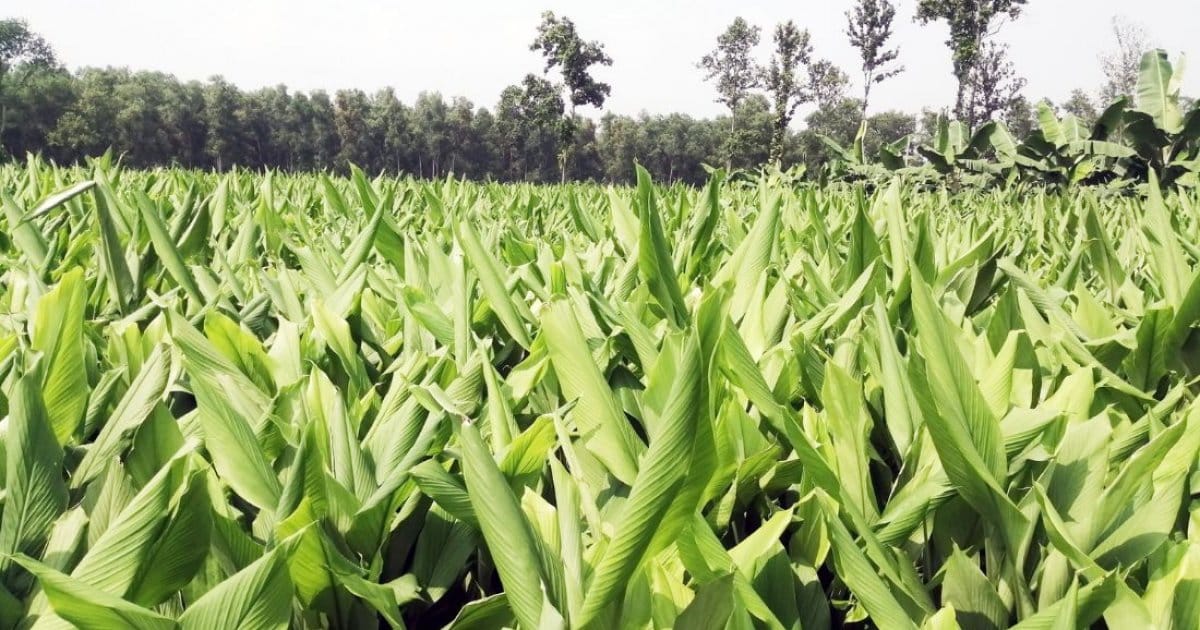Farmers across Tangail district are optimistic about a prosperous turmeric harvest this year, anticipating strong yields and robust market returns—provided weather conditions remain favorable.
With its low input costs, minimal land requirements, and high profitability, turmeric has emerged as a preferred crop among growers, particularly in the hilly upazilas of Ghatail, Madhupur, and Sakhipur.
This season, turmeric cultivation in Madhupur alone spans 980 hectares, with a production target of approximately 12,000 tons.
Last year, farmers cultivated 760 hectares and harvested over 9,000 tons, exceeding expectations.
If market prices hold steady, turmeric sales in Madhupur could reach Tk58 crore, according to local estimates.
Farmers cite several advantages of turmeric farming: the crop is largely resistant to pests, cattle, and goats, and thrives on fallow land with minimal risk of damage.
Its strong demand as a staple spice in Bangladeshi and South Asian cuisine ensures better prices compared to many other crops.
According to the District Agriculture Office, turmeric is currently cultivated on 3,208 hectares across 12 upazilas of Tangail.
Ghatail leads with 1,456 hectares, followed by Madhupur (980 ha), Sakhipur (350 ha), Mirzapur (125 ha), and smaller allocations in Sadar, Basail, Kalihati, Nagarpur, Bhuapur, Gopalpur, Delduar, and Dhanbari.

The region’s red loamy soil—rich in organic matter and ideal for turmeric—has contributed to the crop’s expansion.
Farmers often grow turmeric as an intercrop alongside other produce, maximizing land use and income.
Local varieties such as Harinapalli, Adagati, Mohishbat, Patnai, and Arani remain popular, but high-yielding strains like Dimla and Sinduri are gaining traction.
Dimla yields up to three times more than traditional varieties, while Sinduri offers double the output.
Both are resistant to leaf blight disease. Additionally, BARI-developed strains—BARI Halud-3, BARI Halud-4, and BARI Halud-5—are delivering promising results.
Agriculture experts describe turmeric as a “miracle herb” due to its nutritional and medicinal properties.
Rich in fiber, potassium, vitamin B6, magnesium, vitamin C, and curcumin—a compound known for its therapeutic benefits—turmeric is used not only in cooking but also in cosmetics and the dye industry.
Consuming raw turmeric is believed to aid digestion and enhance skin radiance.
In Madhupur, turmeric is cultivated in areas such as Joynatali, Bhutia, Aronkhola, Beribaid, Kuragacha, Mominpur, Mirzabari, and Gachabari.
Farmers like Nazrul Islam from Brahmanbari village report that turmeric is easier and more profitable than other crops.
“Each bigha costs around Tk35,000 to Tk40,000 to cultivate. If there’s no natural disaster, yields can reach 70 to 80 maunds per bigha, with profits of Tk70,000 to Tk80,000,” he said.
Another farmer, Bappi, noted that turmeric takes seven to ten months to mature, depending on the variety.
“It’s not a troublesome crop. Fertilizer and pesticide use is minimal, and profits can reach Tk60,000 to Tk70,000 per bigha,” he said.
Madhupur Upazila Agriculture Officer Rakib Al Rana emphasized the crop’s resilience and profitability.
“Turmeric is nearly disease-free and often grown as an intercrop. Our office provides continuous support, and sub-assistant agriculture officers monitor fields regularly,” he said.
Mohammad Dulal Uddin, training officer at the Tangail Department of Agricultural Extension, added: “Turmeric has at least 46 medicinal properties. We expect a bumper yield this year. If the weather holds and prices remain favorable, farmers will see substantial profits.”
With expanding acreage, improved varieties, and strong market demand, turmeric cultivation in Tangail is poised to deliver another successful season.



